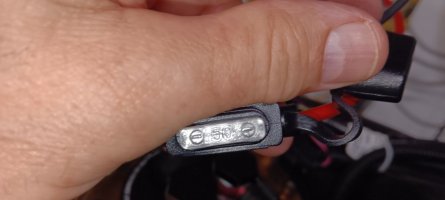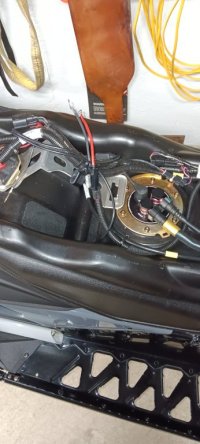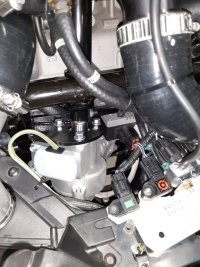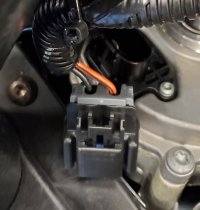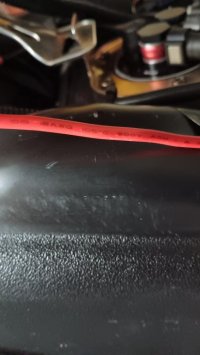KRK1
Newbie
50 amp.What fuse is in the GSE kit?
50 amp.What fuse is in the GSE kit?
Attachments
KRK1
Newbie
KRK1
Newbie
Mine being s 2019 without the smart shocks has the wire lead for the smart shock control module right off the fuse block. Richard Hodgins used the canbus wires from that lead which is my plan there. He also tapped into the fuse wire for the battery under the fuse block which looks to be a good idea and keeps the wiring short to the eps motor. However, how he tapped in?.. he didn't mention. I'm not a fan of scotch lock type connections but maybe they have improved them where long term connectivity issues like corrosion aren't a problem??
When installing the wire for launch control on the 2012 F1100T I had, I carefully stripped the wire in the harness to be used leading to the ECU, wrapped the launch wire around the stripped section, soldered it and then, coated the connection with liquid electrical tape plus a wrap of regular tape. Never had an issue with it. I would do the same here but the wire bundles under the fuse block are tight so I'm not sure if getting a stripping tool in there would work without risk of upsetting the other wiring nearby?
Richard Hodgins it appears by his posted pics, used the ground wire from the above mentioned smart shock lead and jumped it over to the ground side of the power and ground plug to complete that hookup. I'm not sure that is exactly how he did it; he will have to verify but, it looks like it going by his pictures.
When installing the wire for launch control on the 2012 F1100T I had, I carefully stripped the wire in the harness to be used leading to the ECU, wrapped the launch wire around the stripped section, soldered it and then, coated the connection with liquid electrical tape plus a wrap of regular tape. Never had an issue with it. I would do the same here but the wire bundles under the fuse block are tight so I'm not sure if getting a stripping tool in there would work without risk of upsetting the other wiring nearby?
Richard Hodgins it appears by his posted pics, used the ground wire from the above mentioned smart shock lead and jumped it over to the ground side of the power and ground plug to complete that hookup. I'm not sure that is exactly how he did it; he will have to verify but, it looks like it going by his pictures.
YamaSpark
Extreme
- Joined
- Sep 21, 2017
- Messages
- 110
- Location
- Greenfield, Minnesota
- Country
- USA
- Snowmobile
- 2016 SR VIPER S-TX 137 DX
I am almost certain that a factory EPS Winder uses 12 GA wire, but that's coming from the fuse block. I'm not sure if the extra 4 feet of wire going directly to the battery poses a problem, I really doubt that it would. It's not like the EPS motor is constantly drawing 30 amps. Just my 2 cents.Should be based on the amps the unit draws, I guess the best way to know is what is the size of the wire on a Factory installed EPS?
Attachments
50 amp.
50 amp.
Last edited:
KRK1
Newbie
No the wire says 12 awg. I tried taking a picture of the writing on the red wire coming from the fuse holder but it was completely blurry. After several tries to get a clear picture with no luck I gave up on it.Looks like #8 under there.
I would be shocked if it is 12 awg for 50 amps.
KRK1
Newbie
Well I don't know what to tell ya but it is 12 awg.
I had a look at the wiring diagram for a newer sled. It shows the EPS sharing power with rest of the direct connect accessories on the Red/White wire. I just went out and pulled the fuse block out of my sled, and flipped it over to see what ga wire is feeding the 30amp main sled fuse and it also does appear to be 8 ga (maybe) its not labeled. If you are wiring to the main loom from the EPS, you can likely get away with 10ga for that short run, I don't think I would go smaller. The 30 amp circuit is the white/red in the upper left side of the block.

Big Pussy
Extreme
- Joined
- Apr 12, 2016
- Messages
- 95
- Age
- 66
- Location
- Woodstock, Ont
- Country
- Canada
- Snowmobile
- 2015 XF7000 LXR
I think all that wire is Chinese gauge wire like the speaker wire you get at the store. As I said before, the fuse sizes are all too big to protect automotive wire, hence the smoke and fire. They just don't want the fuse to blow. They are designing for short circuit protection and not overload protection.I had a look at the wiring diagram for a newer sled. It shows the EPS sharing power with rest of the direct connect accessories on the Red/White wire. I just went out and pulled the fuse block out of my sled, and flipped it over to see what ga wire is feeding the 30amp main sled fuse and it also does appear to be 8 ga (maybe) its not labeled. If you are wiring to the main loom from the EPS, you can likely get away with 10ga for that short run, I don't think I would go smaller. The 30 amp circuit is the white/red in the upper left side of the block.
View attachment 176361
KRK1
Newbie
Here is a pic of the GSE fuse holder wire. The writing is faint and there is a scratch mark that took off a bit of the number 1 in the 12awg printed on the wire but, you can see it says 12awg. The wire as previously stated past the red fuse holder wire has no writing that I could find by splitting the loom. However, it is the same outer diameter as the fuse wire shown.
I have done some searching on 8 awg wire looking for outer diameter specs and 8awg wire typically is in the .250" plus or minus a few thousands which is much larger than the GSE fuse holder wire shown. I'm pretty sure none of the fuse block wires on these sleds is that large either?
Finally, on Mcmaster Carr I did locate a 8 gauge wire that is listed as .160" outer diameter. It's listed as not available to ship for 2 to 3 weeks and is typically used in marine applications. Any other searches of 8 gauge wire did not bring up any wire under the .250" outer diameter which appears to be the common outer diameter.
I have done some searching on 8 awg wire looking for outer diameter specs and 8awg wire typically is in the .250" plus or minus a few thousands which is much larger than the GSE fuse holder wire shown. I'm pretty sure none of the fuse block wires on these sleds is that large either?
Finally, on Mcmaster Carr I did locate a 8 gauge wire that is listed as .160" outer diameter. It's listed as not available to ship for 2 to 3 weeks and is typically used in marine applications. Any other searches of 8 gauge wire did not bring up any wire under the .250" outer diameter which appears to be the common outer diameter.
Attachments
Last edited:
KRK1
Newbie
The fuse wire outer diametr picture with calipers file is to big to attach. Figures!!! The outer diameter for 12awg wire is commonly around
.160".
.160".
Last edited:
I think all that wire is Chinese gauge wire like the speaker wire you get at the store. As I said before, the fuse sizes are all too big to protect automotive wire, hence the smoke and fire. They just don't want the fuse to blow. They are designing for short circuit protection and not overload protection.
A vehicle sold in NA has to meet NA standards regardless of where the wire or fuse comes from. The fuse is there to protect the circuit, no engineer is going to over rate the fuse just to keep it from blowing because they know the wire would become the fuse. If you want to be sure, you can just check the wire size in a new sled by measuring its diameter without the insulation. For an add-on part however, you only have to specify the wire based on the length of the typical installation, if the customer deviates from that (which is almost never stated in the documentation) then its on the customer. In the case of GSE, it comes with a complete harness so that wire could also be measured (diameter without the insulation).
Big Pussy
Extreme
- Joined
- Apr 12, 2016
- Messages
- 95
- Age
- 66
- Location
- Woodstock, Ont
- Country
- Canada
- Snowmobile
- 2015 XF7000 LXR
So why is the horn circuit on my 2023 RAM wired with little 14 gauge wire but fused with a 20 amp fuse ?A vehicle sold in NA has to meet NA standards regardless of where the wire or fuse comes from. The fuse is there to protect the circuit, no engineer is going to over rate the fuse just to keep it from blowing because they know the wire would become the fuse. If you want to be sure, you can just check the wire size in a new sled by measuring its diameter without the insulation. For an add-on part however, you only have to specify the wire based on the length of the typical installation, if the customer deviates from that (which is almost never stated in the documentation) then its on the customer. In the case of GSE, it comes with a complete harness so that wire could also be measured (diameter without the insulation).
The truck is built in NA to your NA specs.
That white red wire on your fuse block feed is at best 10 gauge. See what happens if the feed wire rubs through to ground near the fuse block end. It will be a red hot wire in less than two seconds since there is no fuse protection at the starter solenoid where it is powered from. There is then a real risk that the sled burns down.

Yamajon1
VIP Member
- Joined
- Nov 6, 2016
- Messages
- 986
- Location
- Oshkosh Wisconsin
- Country
- USA
- Snowmobile
- 2016 SR Viper RTX DX
Former Yamaha sleds:
2004 Venture 600 2002 SX Viper 700
1997 Vmax 600 SX 1994 Vmax 600 1989 Exciter
1986 Vmax 540 1986 Phaser 1981 SRX 440
The little 14 gauge wire most likely only controls the coil side of a horn relay and is powered off a smaller fuse. The 20 amp horn fuse most likely feeds the contact side of the relay That powers the actual horn and will have a larger gauge wire for the higher load.So why is the horn circuit on my 2023 RAM wired with little 14 gauge wire but fused with a 20 amp fuse ?
The truck is built in NA to your NA specs.
That white red wire on your fuse block feed is at best 10 gauge. See what happens if the feed wire rubs through to ground near the fuse block end. It will be a red hot wire in less than two seconds since there is no fuse protection at the starter solenoid where it is powered from. There is then a real risk that the sled burns down.
Similar threads
- Replies
- 5
- Views
- 3K
- Replies
- 19
- Views
- 6K
-
This site uses cookies to help personalise content, tailor your experience and to keep you logged in if you register.
By continuing to use this site, you are consenting to our use of cookies.

